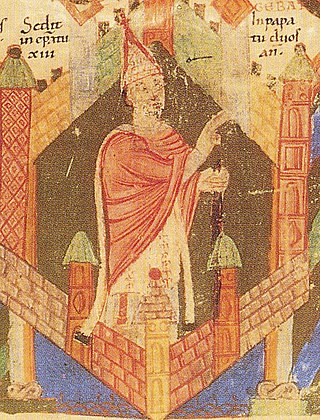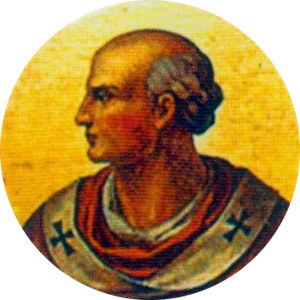Sources
- Caravale, Mario (ed). Dizionario Biografico degli Italiani: L Francesco I Sforza – Gabbi. Rome, 1998.
- Gregorovius, Ferdinand. Rome in the Middle Ages Vol. II. trans. Annie Hamilton. 1905.
Cencio I Frangipane (also Cencius or Centius) was a Roman nobleman of the Frangipani family of the latter half of the eleventh century. [1] He was a Roman consul [2]
His parentage is cited first in 1066, when he appeared as Cencio vir magnificus filio quondam Johannes de Imperator. [3] His father was Giovanni Sardo de Imperator. In 1039, three siblings, Leo, Bernard, and Bona made a donation to Santa Maria Novella as filii quondam Petri Frajapane de Imperator. [4] Peter was the first known member of the family and he clearly carried two surnames. Leo, his son, had two sons, Robert and John, the latter being the father of Cencius. John and Robert were only known by their Imperator name, though Cencius used Frangipane.
Cencius began his career as a follower of the Gregorian reform. His seal appears on a document of Pope Nicholas II investing Abbot Bernard of Farfa with the castles of Tribuco and Arce. The militantly imperialist Benzone, Bishop of Alba, recorded in his Ad Heinricum imperatorem libri VII that Cencius worked to influence the election of Alexander II in 1061. However, despite all this, on 25 December 1075, Pope Gregory VII was kidnapped and imprisoned by Cencius while he was officiating in Santa Maria Maggiore. The pope was liberated by the people, but he accused the Emperor Henry IV of being behind the attempt. The event is often cited as the beginning of Investiture Controversy.
In the 1080s, the Chronica of Monte Cassino referred to Cencius as consul Romanorum or "consul of the Romans." In 1084, when Henry besieged the Eternal City, Cencius sustained Gregory in the Leonine City and negotiated with the Normans of Robert Guiscard, allowing the sack of the city as a reward for rescuing it from Henry, but preserving the pope's liberty and the papal city.
In the election of 1085, Cencius advanced Odo of Lagery, the cardinal-bishop of Ostia and future Pope Urban II, as a candidate. However, the electors selected Desiderius of Benevento as Victor III. Cencius and Victor had strained relations, but he participated in the Council of Capua, at which Victor was confirmed as pope, in March 1087 with the Normans.
Cencius was last mentioned in November 1102 assisting Matilda of Canossa with the distribution of her property.
Pope Stephen IX was the Bishop of Rome and ruler of the Papal States from 3 August 1057 to his death on 29 March 1058. He was a member of the Ardenne-Verdun family, who ruled the Duchy of Lorraine, and started his ecclesiastical career as a canon in Liège. He was invited to Rome by Pope Leo IX, who made him chancellor in 1051 and one of three legates to Constantinople in 1054. The failure of their negotiations with Patriarch Michael I Cerularius of Constantinople and Archbishop Leo of Ohrid led to the permanent East–West Schism. He continued as chancellor to the next pope, Victor II, and was elected abbot of the Benedictine monastery of Montecassino.

Pope Victor II, born Gebhard of Dollnstein-Hirschberg, was the head of the Catholic Church and ruler of the Papal States from 13 April 1055 until his death in 1057. Victor II was one of a series of German-born popes who led the Gregorian Reform.

Pope Victor III, was the head of the Catholic Church and ruler of the Papal States from 24 May 1086 to his death. He was the successor of Pope Gregory VII, yet his pontificate is far less notable than his time as Desiderius, the great abbot of Monte Cassino.
Amadeus II was the count of Savoy from 1078 to 1080. His life is obscure and few documents mention him. During his rule, he was overshadowed by his mother, but he had good relations with the papacy and, for a time, the Holy Roman emperor.

Benedict X, born Giovanni, was elected to succeed Pope Stephen IX on 5 April 1058, but was opposed by a rival faction that elected Nicholas II. He fled Rome on 24 January 1059 and is today generally regarded as an antipope.
Honorius II, born Pietro Cadalo, was an antipope from 1061 to 1072. He was born in the County of Verona, and became bishop of Parma in 1045. He died at Parma in 1072.

Guibert or Wibert of Ravenna was an Italian prelate, archbishop of Ravenna, who was elected pope in 1080 in opposition to Pope Gregory VII and took the name Clement III. Gregory was the leader of the movement in the church which opposed the traditional claim of European monarchs to control ecclesiastical appointments, and this was opposed by supporters of monarchical rights led by the Holy Roman Emperor. This led to the conflict known as the Investiture Controversy. Gregory was felt by many to have gone too far when he excommunicated the Holy Roman Emperor Henry IV and supported a rival claimant as emperor, and in 1080 the pro-imperial Synod of Brixen pronounced that Gregory was deposed and replaced as pope by Guibert.
Sylvester IV, born Maginulf, was a claimant to the Papacy from 1105 to 1111 in opposition to Paschal II. A priest before his election, he was probably a native of Rome. He had the backing of the Roman militia and initially of the Holy Roman Emperor, Henry IV, who later forced him to abdicate. Today he is regarded as an antipope.
Aldruda Frangipane, Countess of Bertinoro, was a twelfth-century Roman noblewoman and military leader.
Pier Leoni was the son of the Jewish convert Leo de Benedicto and founder of the great and important medieval Roman family of the Pierleoni. He was called the Jewish Crassus by Gregorovius.

The Frangipani family was a powerful Roman patrician clan in the Middle Ages. The family was firmly Guelph in sympathy. The name has many spellings, which include Frangipane, Freiapane, Fricapane and Fresapane. In his Trattatello in laude di Dante, Boccaccio traces the descent of Dante from the family.
Landulf VI was the last Lombard prince of Benevento. Unlike his predecessors, he never had a chance to rule alone and independent. The principality lost its independence in 1051, at which point Landulf was only co-ruling with his father, Pandulf III.
Saint Athanasius I was the bishop of Naples from 850 to his death. This Athanasius should not be confused with his nephew, Athanasius II.
Gaitelgrima of Salerno, was princess consort of Capua by marriage to Jordan I of Capua. She was regent of Capua in 1091 during the minority of her sons, Richard, Robert, and Jordan.
The Secretariate of Briefs to Princes and of Latin Letters, or simply the Secretariate of Briefs, was one of the offices of the Roman Curia abrogated in 1967 during Pope Paul VI's reform of the Pontifical court. It was divided into two sections.
Gotebald was the Patriarch of Aquileia during the middle of the eleventh century (1049–1063). He was originally a provost from Speyer. During his reign, the century-old conflict between Old-Aquileia and Grado reached a climax.

Saint Erlembald was the political and military leader of the movement known as the pataria in Milan, a movement to reform the clergy and the church in the Ambrosian diocese.
Oddone Frangipane was a Roman lord and military leader in the service of the Papacy in the 12th century.
Cencius II or Cencio II Frangipane was the son of either of Cencio I or of John, a brother of one Leo. He was the principal representative of the Frangipani family of Rome in the early twelfth century.

The 1086 papal election ended with the election of Desiderius, abbot of Monte Cassino as Pope Gregory VII's successor after a year-long period of sede vacante.